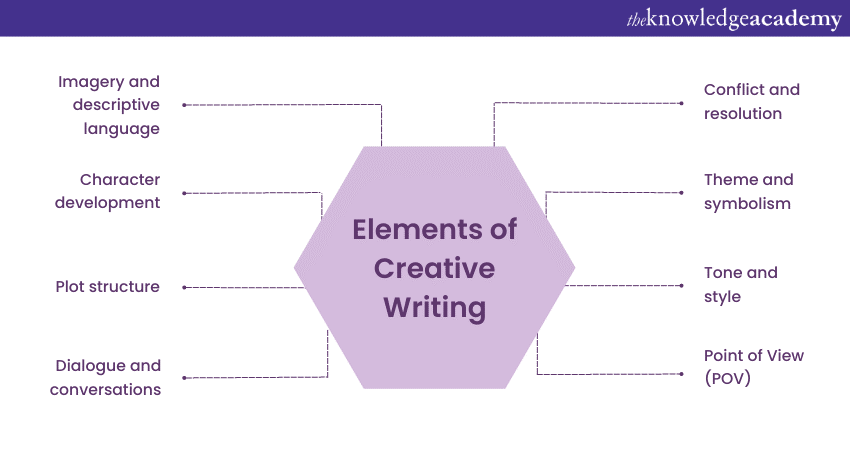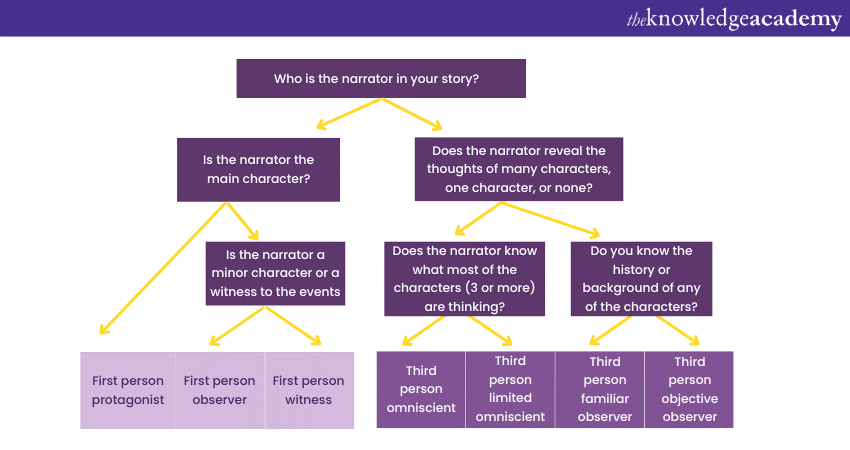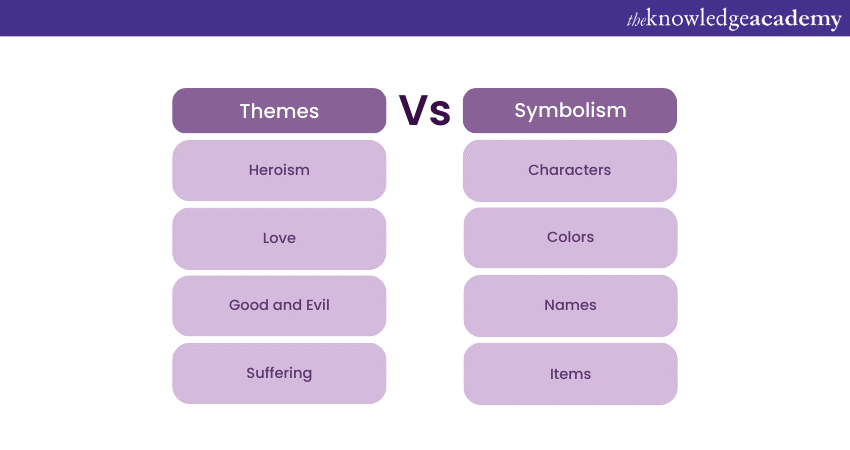We may not have the course you’re looking for. If you enquire or give us a call on 01344203999 and speak to our training experts, we may still be able to help with your training requirements.
Training Outcomes Within Your Budget!
We ensure quality, budget-alignment, and timely delivery by our expert instructors.

Creative Writing is a world where imagination meets language. Creative Writing is an art that allows you to express your thoughts, feelings, and imagination in a unique and engaging way. But what exactly sets Creative Writing apart? Understanding the Elements of Creative Writing.
Whether you're an aspiring novelist, a poet, or simply someone who loves to pen down your ideas, understanding the key Elements of Creative Writing can significantly enhance your skills. In this blog, we will explore the top 10 Elements of Creative Writing that are essential for creating compelling and impactful written works, along with tips.
Table of Contents
1) The importance of Creative Writing elements
2) Top 10 Elements of Creative Writing
a) Imagery and descriptive language
b) Character development
c) Plot structure
d) Dialogue and conversations
e) Point of View (POV)
f) Setting and world-building
g) Tone and Style
h) Conflict and resolution
i) Theme and symbolism
j) Editing and revision
3) Conclusion
The importance of Creative Writing elements
Creative writing isn't confined to the pages of novels or the lines of poetry; it's a fundamental human expression that predates recorded history. It has been a conduit for cultural preservation, knowledge transfer, and emotional catharsis. But how exactly mastering these elements can improve your writing?
Every art has its tools, and Creative Writing is no different. The elements we'll delve into aren't just guidelines; they're the building blocks that transform your words from ordinary to extraordinary. By understanding and mastering these Creative Writing elements, you'll be equipped to craft narratives that draw readers in, keep them engaged, and leave an indelible mark on their minds and hearts.
Top 10 Elements of Creative Writing
Generally, there are various Elements of Creative Writing, each possessing its own unique features. However, many forms of Creative Writing also share some common features. Here’s a detailed explanation of each element every Writer must follow:

1) Imagery and descriptive language
Imagery and descriptive language are the brushes with which writers paint vivid mental pictures for their readers. By skillfully weaving sensory details, you bring scenes to life and evoke emotions. The rustling leaves, the scent of freshly baked bread, the gritty texture of sand beneath one's feet—these details create a sensory symphony that immerses readers in your world.
Metaphors, similes, and analogies act as bridges, connecting the familiar with the unfamiliar. Through them, you can compare the indescribable to the known, enriching your narrative with layers of meaning. Mastery of imagery and descriptive language transforms passive reading into an active experience where readers can taste, smell, hear, see, and feel the world you've created.
Tips:
a) When selecting details, focus on the ones that have the most impact and avoid including unnecessary clutter.
b) Use metaphors and similes sparingly, making them truly resonate.
c) Tailor your descriptions to the tone and mood of the scene or story.
2) Character development
Character development is the art of breathing life into your fictional personas. Well-crafted characters are not only relatable but also complex, with layers of personality, desires, flaws, and history. They drive the plot forward, compelling readers to invest emotionally in their journeys. Backstories provide context, explaining why characters behave the way they do.
Effective character development allows readers to understand, empathise, and even dislike characters. The key lies in making them authentic and evolving. Just as people change, so should your characters. They learn, grow, and adapt, making their arcs believable and satisfying. The beauty of character development is in its ability to mirror the human experience, forging connections between fictional worlds and real hearts.
Tips:
a) Explore your characters' pasts to understand their motivations and fears.
b) Create a character profile detailing their appearance, background, and personality traits.
c) Show character development through actions and decisions rather than telling.
Unlock your creative potential with our expert-led Creative Writing Training – Register now to ignite your imagination!
3) Plot structure
Plot structure is the architecture that holds your narrative together. Think of it as a roller coaster, with highs and lows that keep readers engaged. The introduction sets the stage, introducing characters, settings, and the initial conflict. Rising action builds tension, propelling the story forward. At its peak is the climax, the turning point that determines the characters' fate.
Falling action allows for a gradual untwisting of events, leading to the resolution. Effective plot structure balances pacing, ensuring readers remain intrigued without feeling rushed. Twists and turns add surprise, while cause-and-effect relationships maintain coherence. A well-structured plot keeps readers invested, eagerly flipping pages to discover what happens next.
Tips:
a) Introduce the main conflict early to hook readers' curiosity.
b) Use cliffhangers and unexpected twists to maintain suspense.
c) Ensure each scene contributes to character development or plot progression.
4) Dialogue and conversations
Dialogue and conversations are windows into your characters' minds and hearts. Natural and dynamic dialogue conveys information and reveals personalities and relationships. Each character's speech patterns, vocabulary, and tone should be distinct, reflecting their backgrounds and emotions.
Through dialogue, conflicts can be ignited, alliances forged, and secrets unveiled. Subtext—the unspoken thoughts beneath the spoken words—adds depth and intrigue. Conversations can quicken the story's pace, providing relief from dense narrative passages. Dialogue-driven scenes foster engagement, inviting readers to eavesdrop on captivating interactions that fuel the narrative's fire.
Tips:
a) Listen to real conversations to capture natural rhythms and speech patterns.
b) Use interruptions and nonverbal cues to make dialogue dynamic.
c) Balance dialogue with narrative to avoid overwhelming the reader.
5) Point of View (POV)

Point of view (POV) is the lens through which your story is perceived. The choice of POV shapes the reader's relationship with characters and events. First-person offers intimacy, allowing readers to see the world through a character's eyes. Second person immerses readers directly into the narrative. Third person limited provides insight into a character's thoughts, while third-person omniscient offers a broader perspective.
Consistency in POV is vital; changing viewpoints can confuse readers. The chosen POV influences what readers know and when they know it. It also affects emotional connection and empathy. Selecting the appropriate POV requires consideration of the story's needs and the desired reader experience.
Tips:
a) Experiment with different POVs to find the best fit for your story.
b) Consider the level of intimacy and distance you want between characters and readers.
c) Be aware of the limitations and advantages of each POV.
6) Setting and world-building
The setting isn't just a backdrop; it's a dynamic element that influences mood and plot. A well-defined setting isn't merely a stage but an active participant, influencing characters and events. You transport readers to a different reality through meticulous detail, allowing them to immerse themselves fully.
Effective world-building extends beyond the physical, encompassing societal norms, rules, and even magic systems in speculative fiction. The environment can reflect themes and impact mood. Whether in a fantasy realm or a contemporary city, the authenticity of the setting enhances the reader's experience.
Tips:
a) Research settings thoroughly to ensure accuracy and authenticity.
b) Show how characters interact with their environment to convey their experiences.
c) Create a sense of place by using unique and specific details.
7) Tone and style
Tone and style are the fingerprints that make your writing uniquely yours. The tone is the distinctive way you express yourself through words—a combination of tone, diction, and syntax. It reflects your personality as an author. Style encompasses sentence structure, pacing, and word choice, influencing the overall feel of your work.
A comedic style might employ wordplay and witty dialogue, while a dramatic style could use evocative descriptions and emotional introspection. Finding your voice and style involves self-discovery and experimenting with different approaches until you uncover what feels authentic. A strong voice and style leave an indelible mark on readers, making your work instantly recognisable
Tips:
a) Read more to familiarise yourself with different writing styles.
b) Practice writing in different tones to discover your preferred voice.
c) Revise with a focus on refining your voice; eliminate elements that don't align.
8) Conflict and resolution
Conflict and resolution are the engine that drives your narrative forward. Conflict introduces challenges that characters must overcome, making their journeys compelling and relatable. There are various types of conflict—internal struggles within characters, external conflicts with other characters or nature, and interpersonal conflicts between characters. Conflict creates tension, propelling the story toward its climax.
The resolution, whether happy or bittersweet, provides closure and offers insights into the characters' growth. Well-crafted conflicts test characters' limits, forcing them to confront their fears, flaws, and desires. Through the resolution, readers witness the transformation and the culmination of the character's arcs.
Tips:
a) Vary the types of conflict to maintain reader engagement.
b) Build tension gradually; escalate the stakes as the story progresses.
c) Avoid convenient solutions; resolutions should arise from the characters' choices and actions.
Supercharge your writing skills with our Speedwriting Course – Register now and amplify your productivity!
9) Theme and symbolism

Theme and symbolism lend depth and layers to your writing. Themes are the underlying ideas, beliefs, or messages that resonate with readers. They can explore love, friendship, power, or mortality, connecting the narrative to universal human experiences. Symbolism employs objects, actions, or concepts to convey abstract ideas, often adding an element of intrigue.
A red rose might symbolize love or passion, while a broken mirror could represent self-perception. Themes and symbols intertwine, enriching the story's interpretation and emotional impact. Skilful use of theme and symbolism transforms a tale into an exploration of human nature and society.
Tips:
a) Reflect on the themes that resonate with you and explore them in your writing.
b) Use recurring symbols to reinforce thematic elements.
c) Allow themes to emerge naturally from the characters' struggles and growth.
10) Editing and revision
Editing and revising are the crucial phases that turn your initial draft into a polished masterpiece. Writing is rewriting; the initial draft is a raw exploration of ideas. Editing involves refining sentences for clarity, coherence, and flow. It ensures grammar and punctuation are correct. Revising delves deeper, examining plot holes, character consistency, and thematic resonance.
Seeking feedback from peers or professionals is invaluable, offering fresh perspectives. The revision process is where your story truly comes to life. It's an opportunity to tighten narrative threads, enhance descriptions, and amplify emotions. Embrace the iterative nature of editing and revising; each pass brings your writing closer to its full potential.
Tips:
a) Revise in multiple passes, focusing on different aspects in each round.
b) Cut unnecessary details or scenes that don't contribute to the narrative.
c) Pay attention to grammar, punctuation, and spelling to ensure a polished final product.
Conclusion
Creative Writing is a journey of discovery, both for the Writer and the reader. In this blog post, we've explored the essential elements that constitute effective Creative Writing. From the foundation of imagination to the nuances of dialogue, style, and conflict, each element plays a pivotal role in crafting a compelling narrative. By mastering these top 10 Elements of Creative Writing, you'll be equipped to create stories that resonate, inspire, and captivate audiences.
Eevate your Copywriting skills to new heights with our Copywriting Course – Join today and craft compelling content that captivates your audience!
Frequently Asked Questions
Upcoming Business Skills Resources Batches & Dates
Date
 Creative Writing Course
Creative Writing Course
Fri 3rd Jan 2025
Fri 7th Mar 2025
Fri 2nd May 2025
Fri 4th Jul 2025
Fri 5th Sep 2025
Fri 7th Nov 2025







 Top Rated Course
Top Rated Course



 If you wish to make any changes to your course, please
If you wish to make any changes to your course, please


